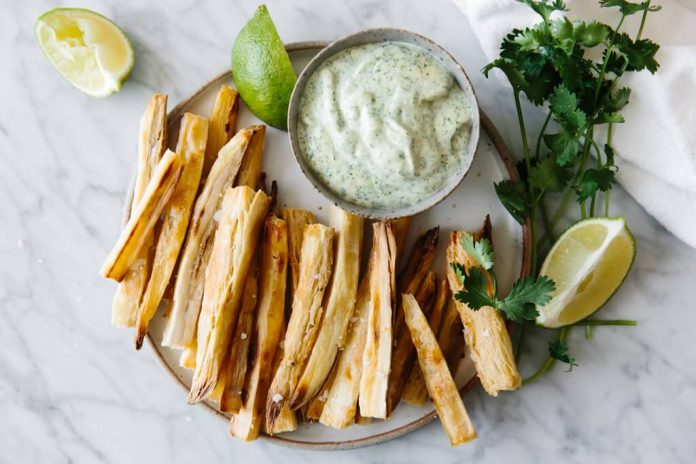The cassave, cassava or yuca plant for Arubans appears to have originated in Brazil and Paraguay and especially around the Amazon and Orinoco river basins. The root of this particular plant is used as a staple to make all kinds of food and as a flat bread that looks much like a tortilla. Manihot esculenta, commonly called cassava, manioc, yuca, macaxeira, mandioca, kappa kizhangu and aipim, is a woody shrub. The Cassave has been spread by Amerindians throughout tropical areas of South, Central America and the Caribbean islands long before the arrival of the Europeans, and has become a world food just as corn, potatoes and tomatoes between many who are Native to the American continent, staples which great civilizations has thrived upon.
The Cassava (Manihot esculenta) also known as yuca is sometimes confused with an agave species of North America. However, the plant yucca, written with two letter c, is what is referred to as the North American plant and yuca with only one c in what our story is about. The confusion may stem from cassava often being referred to as yuca.
Cassava or yuca is a root vegetable. The root can be eaten and in some cultures is it even used as a medicine. Cassava is used for tiredness, dehydration in people with diarrhea, sepsis, and to induce labor yet there is no scientific evidence to support these claims.
The cassava is a basic food for many rural families with low resources. It has been considered a valuable food from times of the aboriginal ones forming part of the selection of roots and tubers that the Cubans commonly denominate as `viandas.’
It is known that one of the most recurrent Caribbean indigenous foods in their diet was the yuca or casabe, food made from cassava that grew in these fields and predominated among Siboneyes, Caquetios and Taínos, who were engaged in harvesting and agriculture, respectively. This was the first typical meal of the Caribbean nations – a substitute for the basic wheat bread diet. There was a saying widely used in popular Cuban slang and taken from the colonizers, “In the absence of bread, casabe.”
In the United States, cassava root is also known by other common names such as, bitter cassava, manioc, tapioca, Brazilian arrowroot, and yuca.
Cassava and tapioca flour are not the same thing.
While sometimes the terms cassava flour and tapioca flour are used interchangeably, there are in fact distinct differences. Tapioca is a starch extracted from the cassava root through a process of washing and pulping. The wet pulp is then squeezed to extract a starchy liquid. Once all the water evaporates from the starchy liquid, the tapioca flour remains.
Alternatively, cassava flour is the whole root, simply peeled, dried and ground. This means it has more dietary fiber than tapioca flour.
In Aruba, native farmers used to plant and eat this root in many ways. As cassava bread, the flour was mixed with water in to a mash and cooked on a hot iron or clay plate. It was also a stew ingredient eaten fried. The grounded yuca root was also cooked up and used as starch for clothing.
Words of a renowned DR multimedia artist,Geo Ripley, “The Cassava is an Amerindian cultural patrimony which has perpetuated in time and space till our days, and a symbol for us, of this Caribbean Sea, which always had unified us and never had separated us.”
To get to know more about Aruba and its origins, its animals and culture, we highly recommend you to book your visit to our renowned cultural center, where encounter sessions have been entertaining curious participants for decades. Mail us at etnianativa03@gmail.comto confirm your participation. Our facilities and activities take place close to high rise hotels.
















